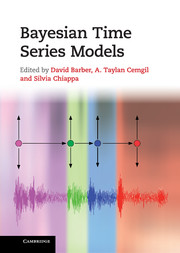Book contents
- Frontmatter
- Contents
- List of contributors
- Preface
- 1 Inference and estimation in probabilistic time series models
- I Monte Carlo
- II Deterministic approximations
- III Switching models
- IV Multi-object models
- V Nonparametric models
- 14 Markov chain Monte Carlo algorithms for Gaussian processes
- 15 Nonparametric hidden Markov models
- 16 Bayesian Gaussian process models for multi-sensor time series prediction
- VI Agent-based models
- Index
- Plate section
- References
16 - Bayesian Gaussian process models for multi-sensor time series prediction
from V - Nonparametric models
Published online by Cambridge University Press: 07 September 2011
- Frontmatter
- Contents
- List of contributors
- Preface
- 1 Inference and estimation in probabilistic time series models
- I Monte Carlo
- II Deterministic approximations
- III Switching models
- IV Multi-object models
- V Nonparametric models
- 14 Markov chain Monte Carlo algorithms for Gaussian processes
- 15 Nonparametric hidden Markov models
- 16 Bayesian Gaussian process models for multi-sensor time series prediction
- VI Agent-based models
- Index
- Plate section
- References
Summary
Introduction
Sensor networks have recently generated a great deal of research interest within the computer and physical sciences, and their use for the scientific monitoring of remote and hostile environments is increasingly commonplace. While early sensor networks were a simple evolution of existing automated data loggers, that collected data for later offline scientific analysis, more recent sensor networks typically make current data available through the Internet, and thus, are increasingly being used for the real-time monitoring of environmental events such as floods or storm events (see [10] for a review of such environmental sensor networks).
Using real-time sensor data in this manner presents many novel challenges. However, more significantly for us, many of the information processing tasks that would previously have been performed offline by the owner or single user of an environmental sensor network (such as detecting faulty sensors, fusing noisy measurements from several sensors, and deciding how frequently readings should be taken), must now be performed in real-time on the mobile computers and PDAs carried by the multiple different users of the system (who may have different goals and may be using sensor readings for very different tasks). Importantly, it may also be necessary to use the trends and correlations observed in previous data to predict the value of environmental parameters into the future, or to predict the reading of a sensor that is temporarily unavailable (e.g. due to network outages).
- Type
- Chapter
- Information
- Bayesian Time Series Models , pp. 341 - 362Publisher: Cambridge University PressPrint publication year: 2011



